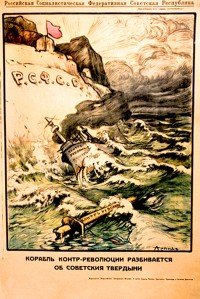Apsit, Aleksandr Petrovich (Apsītis, Aleksandrs)
Born 1880, Riga, Latvia, Russian Empire; died 1944 (location unknown), Germany
Alexandr Petrovich Apsit grew up amidst dire poverty and yet he received free instruction under the tutelage of the Saint-Petersburg painter, Lev Dmitriev-Kavkazskii. By 1902, Apsit was noticed by the popular journals, including Rodina [Motherland], Zvezda [Star], and Niva, for which he produced sketches. He also illustrated the publications of writings by A.M. Gorkii, N.S. Leskov, and A.P. Chekhov, as well as those by D. Bedny, I.S. Nikritin, and M.E. Saltykov-Shchedrin. Through these commissions he gained a stellar reputation, becoming one of the best-paid illustrators in the city.
He began to exhibit in 1903. In 1905, he made his foray into caricature drawings, which he produced for satirical journals, such as Dukh vremeni [The Sprint of the Times] and many others. Apsit's biographers indicate that the extent of his commitment [to the revolution] was stong. Regardless of his level of partisanship, in 1918 at the beginning of the Civil War, Apsit dedicated himself exclusively to the production of political posters for the Council of People's Commissars (SovNarKom). As a result, he established himself as one of the leading artists of early Revolutionary political posters. Near the end of the Civil War around 1921, he made his way back to Riga, Latvia and settled there. In 1939, Apsit moved to Germany where he died in 1944. Details of his death remain unknown.
Although Apsit created a number of canonical political posters of the early Soviet period, his contemporary critics including Viacheslav Polonski, and latter-day Soviet critics, assailed his work. In particular, fellow graphic artist Dimitri Moor chastised Apsit's posters for their stylistic heterogeneity. During the time of a relative liberalization under Nikita Khrushchev (1953-1964), it appears that Apsit's contribution to the development of the visual vocabulary of Soviet political posters was rehabilitated. In a seminal study of early revolutionary posters published in 1960, the author Boris Butnik-Siverskii introduced a more lenient, post-Stalinist assessment of Apsit's oeuvres, positioning him as one of the most important founders of the genre.
Fuentes
Bonnell, V. E. (1999). Iconography of power: Soviet political posters under Lenin and Stalin. Berkeley: University of California Press. (PP. 26, 32, 195, 286)
Milner, J. (1993). A dictionary of Russian and Soviet artists 1420-1970. Woodbridge: Antique Collectors' Club. (PP. 49-50)
Stites, R. (1991). Revolutionary dreams: Utopian vision and experimental life in the Russian revolution. New York: Oxford University Press. (P. 107)
White, S. (1988). The Bolshevik Poster. New Haven: Yale University Press. (PP. 25-32)
Vol'tsenburg, O.E., et al. (1970). Biobibligraphicheskii slovar' khudozhniki narodov SSSR (Vol. 1, P. 182). Moscow: Iskusstvo.
Butnik-Siverskii, B. S. (1960). Sovetskii plakat epokhi grazhdanskoi voiny, 1918-1921. Moskva: Izd-vo Vsesoiuznoi knizhnei palaty. (PP. 35, 45-50, 539)
Baburina, N. I. (1988). The Soviet Political Poster, 1917-1980. New York: Penguin. (bio, artist)
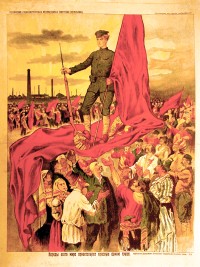
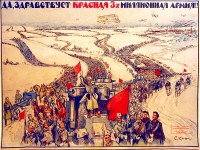
![PP 025: Primer aniversario del Ejército Rojo 1918-1919. “Soy campesino, hijo de proletario, y seré soldado del Ejército Rojo mientras pueda empuñar un arma con mis manos, contra el odio de los enemigos de los trabajadores." [Traducción parcial]](https://www.posterplakat.com/thumbs/the-collection/posters/pp-025/pp025-200x261.jpg)
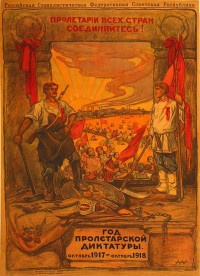
![PP 056: 1 de Mayo
[Karl Marx escribió]
“Los obreros nada tienen que perder, sino el mundo entero que ganar”.](https://www.posterplakat.com/thumbs/the-collection/posters/pp-056/pp056-200x300.jpg)
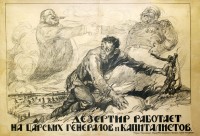
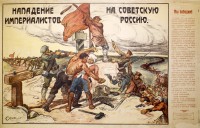
![PP 450: [En la parte superior, en el pergamino]
Por qué necesitamos la cuenca de Donetsk.
[En el pergamino pequeño, bajo el soldado con la bandera roja]
Los yacimientos de carbón alrededor de Donetsk deben ser nuestros.
¡Soldados del Ejército Rojo, a las armas! ¡Obreros y campesinos, a las armas!
Hay que aplastar a las hordas de general zarista Denikin quien, para beneficiar a kulaks y terratenientes, quiere matar de hambre a los obreros y campesinos revolucionarios.
[Traducción parcial]](https://www.posterplakat.com/thumbs/the-collection/posters/pp-450/pp450-200x297.jpg)
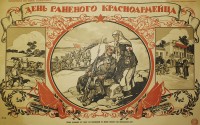
![PP 742: The Tsar, Priest and Rich Man [are] on the Shoulders of Working People.
Three lords of the world are riding on the shoulders of workers and peasants over barren, ruined earth, over bones and bodies of dead peasants.
These three lords are the Tsar, the Priest and the greedy, insatiable, rich Capitalist.
[Partial translation]](https://www.posterplakat.com/thumbs/the-collection/posters/pp-742/pp742-200x300.jpg)
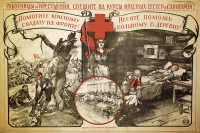
![PP 792: Organize Country Houses of Reading.
Learning is Light. Ignorance is Darkness. Knowledge is Power.
[Partial translation]](https://www.posterplakat.com/thumbs/the-collection/posters/pp-792/pp-792-catalog-image-196x300.jpg)
![PP 793: Organize Country Houses of Reading.
[Partial translation]](https://www.posterplakat.com/thumbs/the-collection/posters/pp-793/pp-793-catalog-image-200x300.jpg)
![PP 893: Internacional.
¡Arriba, los que están marcados por la maldición, un mundo entero de hambrientos y esclavizados!
Nuestras mentes indignadas están en ebullición, listas para llevarnos a una lucha a muerte.
Destruiremos todo este mundo de violencia hasta los cimientos, y luego construiremos un mundo nuevo.
¡Aquel que nada era, todo lo será!
[Traducción parcial]](https://www.posterplakat.com/thumbs/the-collection/posters/pp-893/pp-893-catalog-image-200x300.jpg)
